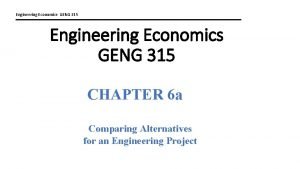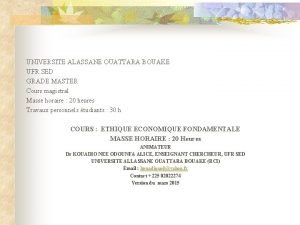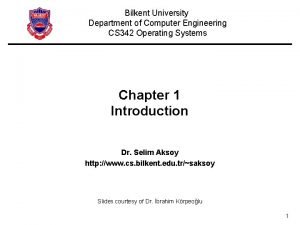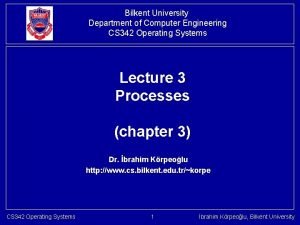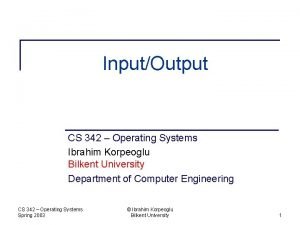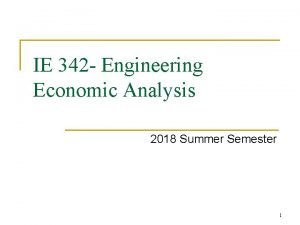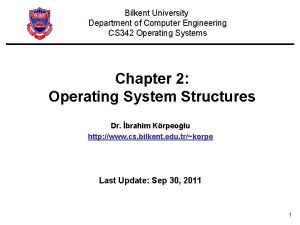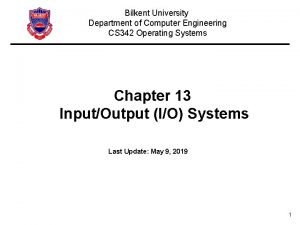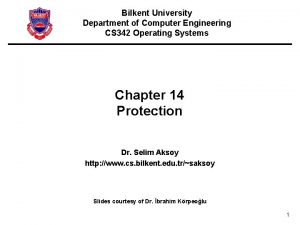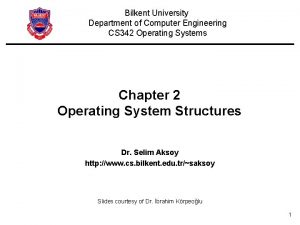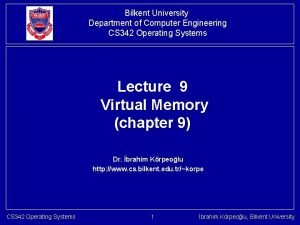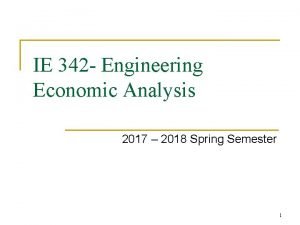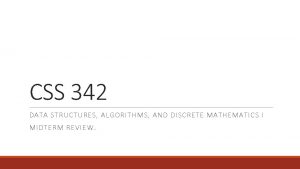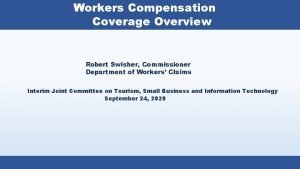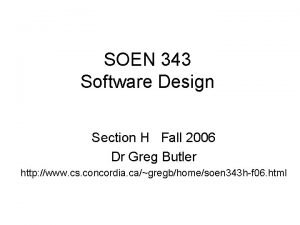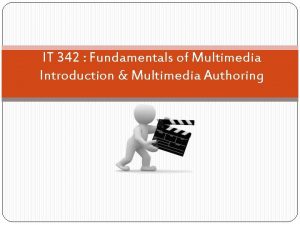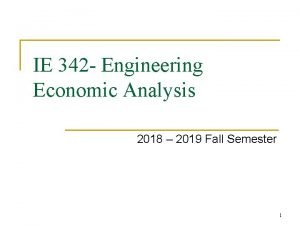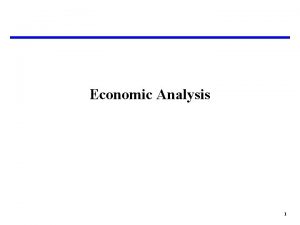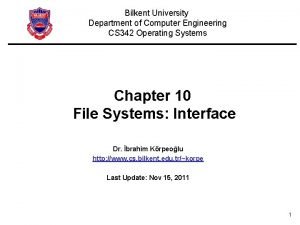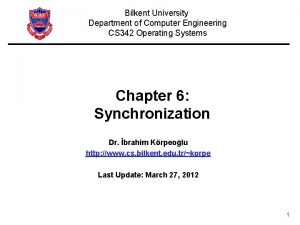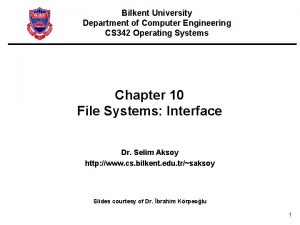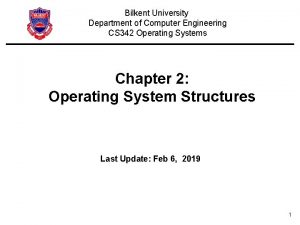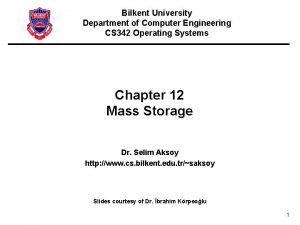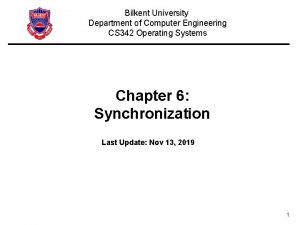IE 342 Engineering Economic Analysis 2018 2019 Summer

























- Slides: 25

IE 342 - Engineering Economic Analysis 2018 – 2019 Summer Semester

IE 342 - Engineering Economic Analysis Instructor Dr. Emre Uzun (Sec 5) E-mail: emreu@bilkent. edu. tr Offıce: EA 328 Tel: x 3484 Office Hours: By appointment via email Teaching Assistants TBA

Course Description • Concepts of time value of money. • Analysis of engineering decisions. • Principles and methodology of comparing decision alternatives, such as various engineering designs, manufacturing equipment, or industrial projects. • Effects of depreciation, inflation and taxation on economic decisions, cost benefit analysis of public projects. • Dealing with uncertainty and risk; rational decision making when future outcomes are uncertain. • Replacement analysis.

• Required Text Book: Park, C. S. , Contemporary Engineering Economics, 6 th Ed. , Prentice Hall, 2016

Grading • • • Midterm - 35 % Final Exam - 40 % 2 Quizzes - 16 % Class Participation - 9 % Total - 100% • Study Sets (will not be graded)

Policies • Attendance: – Due to new regulations, attendance will have to be taken in ALL lectures. However, attendance does NOT have a direct effect on your class participation. ATTENDANCE ≠ CLASS PARTICIPATION • FZ Grade Policy: – No FZ this semester!

Web Site/Email: Policies • https: //courses. ie. bilkent. edu. tr/ie 342 • Students are responsible for all the announcements made in class, on the web page or via e-mail. • It is the students’ responsibility to be aware of what has been covered in lectures, and to check the web page and e-mail accounts regularly and not miss any activity or information

Policies • Makeup Policy: – A make-up examination for the midterms will only be given under highly unusual circumstances (such as serious health or family problems). The student should contact the instructor as early as possible and provide the instructor with proper documentation (such as a medical note certified by Bilkent University’s Health Center). – There is no make-up for quizzes. • Classroom Policy: – No need to come to classroom if you are not in the mood for learning!

Tentative Course Outline: • • • • Ch. 1: Engineering Economic Decisions Ch. 3: Time Value of Money Ch. 3: Economic Equivalence Ch. 3: Interest Formulas - Single Cash Flows Ch. 3: Interest Formulas – Equal Payment Series Ch. 3: Interest Formulas – Gradient Series Ch. 3: Unconventional Equivalence Calculations Ch. 4: Nominal and Effective Interest Rates Ch. 4: Equivalence Analysis using Effective Interest Rates Ch. 4: Debt Management Ch. 4: Investing in Financial Assets Ch. 5: Payback Period Ch. 5: Discounted Cash Flow Analysis

Tentative Course Outline: • • • • Ch. 5: Variations of Present Worth Analysis Ch. 5: Comparing Mutually Exclusive Alternatives Ch. 6: Annual Equivalent Worth Criterion Ch. 6: Applying Annual Worth Analysis Ch. 7: Rate of Return Analysis Ch. 7: Finding Ro. R Ch. 7: Internal Rate of Return Criterion Ch. 7: Incremental Analysis Ch. 9: Asset Depreciation Ch. 9: Depreciation Methods Ch. 9: Corporate Income Taxes Ch. 10: Developing Project Cash Flows Ch. 11: Meaning and Measure of Inflation Ch. 11: Equivalence Calculation under Inflation Ch. 11: Effects of Inflation of Project Cash Flows

Tentative Course Outline: • • Ch. 12: Decision Tree Analysis Ch. 14: Replacement Analysis Fundamentals Ch. 14: Replacement Decision Models Ch. 15: Methods of Financing Ch. 15: Cost of Capital Ch. 15: Choice of MARR Ch. 16: Benefit-Cost Ratio

Engineering Economic Decisions

Getting a Car in the USA

Getting a Car in the USA

A Simple Illustrative Example: Car to Finance – Audi or BMW? § § § Recognize the decision problem Collect all needed (relevant) information Identify the set of feasible decision alternatives Define the key objectives and constraints Select the best possible and implementable decision alternative • Need to get a car • Gather technical and financial data Select cars to consider Wanted: small cash outlay, safety, good performance, aesthetics, … Choice between Audi and BMW (or others) Select the car • •

Engineering Economic Decisions Investment Planning Marketing Manufacturing Plan for the acquisition of equipment (capital expenditure) that will enable the firm to design and produce products economically Profit

What Makes Engineering Economic Decisions Difficult? • • • Estimating a required investment Forecasting a product demand Estimating a selling price Estimating a manufacturing cost Estimating a product life

Large-Scale Engineering Projects These typically • require a large sum of investment • can be very risky • take a long time to see the financial outcomes • lead to revenue and cost streams that are difficult to predict All the above aspects (and some others not listed here) point towards the importance of EEA

Common Types of Strategic Engineering Economic Decisions • • • Equipment or process selection Equipment replacement decisions New products and product expansion Improvement in service or quality Cost reduction

Fundamental Principles of Engineering Economics • Principle 1: An instant dollar is worth more than a distant dollar. • Principle 2: The only thing that matters is the difference between alternatives. • Principle 3: Marginal revenue must exceed marginal cost. • Principle 4: Additional risk is not taken without the expected additional return.

Principle 1 An instant dollar is worth more than a distant dollar… Today 6 months later

Principle 1 An instant dollar is worth more than a distant dollar… Interest rate = 10% $110 one $100 year today later $121 two years later

Principle 2 The only thing that matters is the difference between alternatives. Option Monthly fuel cost Monthly maintenance Cash outlay at signing Monthly payment Buy $960 $550 $6, 500 $350 $9, 000 Lease $960 $550 $2, 400 $550 0 Irrelevant items in decision-making Salvage value at end of year 3

Principle 3 Marginal revenue must exceed marginal cost. Marginal cost Manufacturing cost Sales revenue 1 unit Marginal revenue

Principle 4 Additional risk is not taken without the expected additional return. Investment Class Potential Risk Expected Return Savings account (cash) Low/None 1. 5% o Bond (debt) Moderate 4. 8% o Stock (equity) High o 11. 5%
 Engineering economic analysis procedure
Engineering economic analysis procedure Dada la siguiente secuencia rusia 2018 rusia 2018
Dada la siguiente secuencia rusia 2018 rusia 2018 Conest control escolar
Conest control escolar Ufr sed bouaké
Ufr sed bouaké Bccie summer conference 2018
Bccie summer conference 2018 Alpbach summer school 2019
Alpbach summer school 2019 Www.edd.ca.gov@eddreportfraud
Www.edd.ca.gov@eddreportfraud Cs 342
Cs 342 Cs342 bilkent
Cs342 bilkent Multimedia authoring metaphors
Multimedia authoring metaphors Ibrahim korpeoglu
Ibrahim korpeoglu Emre uzun bilkent
Emre uzun bilkent 300 e yuvarlanan en büyük ve en küçük sayı
300 e yuvarlanan en büyük ve en küçük sayı Delta studio outlet
Delta studio outlet Cs 342 bilkent
Cs 342 bilkent Cs 342 bilkent
Cs 342 bilkent Cs 342
Cs 342 Cs 342 bilkent
Cs 342 bilkent Cs 342 bilkent
Cs 342 bilkent Ie 342
Ie 342 Jesus é meu amigo meu guia, meu senhor
Jesus é meu amigo meu guia, meu senhor Css 342
Css 342 342 3
342 3 Krs 342
Krs 342 Soen 342
Soen 342 Multimedia tools
Multimedia tools
